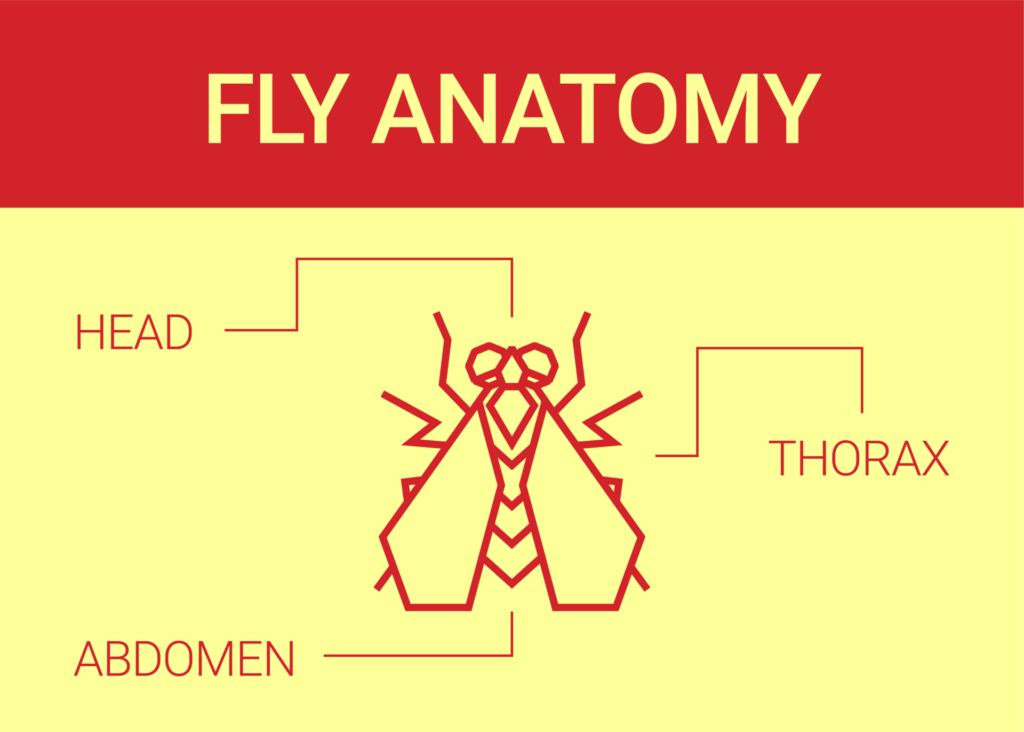Houseflies are a common annoyance during the spring and summer months. These creatures fly around with great speed and are adept at escaping predators (or a flyswatter). They’re also known to carry disease and sometimes bite. However, flies are more complex creatures than they seem, and knowing their anatomy and how they function can help a homeowner know how to deal with them.

The Head
A housefly’s head is where its eyes, antennae and mouthparts are. Houseflies do not have teeth or the capacity to chew, so they must consume liquid food. If the food is already in liquid form, so much the better for them. If the food is solid, they must first digest it.
How A Fly Eats
Where humans digest food beginning in the mouth and then in the intestines and stomach, a fly begins digesting its food on the outside of its body. First, the fly uses its antennae to smell out its food and land on it. If food is too solid for the fly to consume, it will first mop up the bits that it can and then vomit saliva and digestive juices onto the food particle. Once the food particle is soft enough to eat, the fly then mops or sucks up both the food and the digestive juices with its mouthparts, and the food goes directly to its stomach. Sometimes, if a fly can’t digest the food completely, it sends the food to an inner sac called a crop, where it continues to be broken down until it can be ingested.
The saliva and digestive juices that a fly vomits onto its food are unhygienic and can carry disease. They may also stick to a fly’s legs, which is why you don’t want flies coming near your food—especially if the fly’s most recent meal was trash or rotting organic matter. If the fly lands, it may leave deposits of previous meals or its digestive fluids on your food.
How A Fly Sees
Flies have two complex eyes. These eyes are made up of thousands of individual simple eyes, which compile images into a mosaic of vision that allows the fly to see the slightest movements from every direction (which is why they are so often hard to swat). Additionally, they have three other simple eyes located between these two that detect light and help them to know which way is up.
The Body
A fly’s main body is made of a thorax and an abdomen. These parts are covered by a hard exoskeleton made of a bony substance called chitin.
Thorax
The thorax is where the fly’s legs and wings are attached. Flies have six legs covered in bristles that help them to taste their food, along with tiny claws and suction that helps them to stick to almost any surface. If you see a fly walking around on a surface or on your food, it’s probably tasting it.
Flies have four wings: two that are obviously visible and help it fly around, and two tiny, stub-like ones called halters that help it have balance while in flight. The combination of these wings gives the fly great maneuverability in the air, allowing it to take flight in an instant and even make complex patterns and movements while in flight.
Abdomen
The abdomen is the farthest-back part of a fly’s anatomy. It contains vital parts such as the reproductive organs, which are retracted when not in use. A female housefly, when fertilized, can lay up to 900 eggs in her short, three-month-maximum lifespan. These eggs, which are tiny, grain-like, oval and white, hatch into wormlike maggots which grow into pupa and from there into adult flies.
Getting Rid of Flies
You can use several simple techniques to get rid of flies. Besides swatting them, which can actually scatter the germs they carry into your home environment, these techniques include:
- Fly paper and traps
- Keeping doors and windows shut and letting in fresh air through screens
- Keeping your home clean and sanitary to eliminate sources of food or places to reproduce.
If you think you might have a fly infestation, whether through seeing lots of flies in your house or finding their larvae, contact us today for a free inspection!
